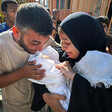Rights and Accountability 14 August 2015

Newborn babies at a shelter for Gaza families displaced by Israel’s bombing, August 2014.
APA imagesThe infant mortality rate in the occupied Gaza Strip has risen for the first time in 50 years, according to a newly published survey.
“The number of babies dying before the age of 1 has consistently gone down over the last decades in Gaza, from 127 per 1,000 live births in 1960 to 20.2 in 2008,” the study by UNRWA, the United Nations agency for Palestine refugees, states. In 2013, it had risen to 22.4 per 1,000 live births.
The number of babies in Gaza dying before they turn four weeks old soared by 70 percent, from 12 per 1,000 live births in 2008 to 20.3 in 2013.
“Progress in combatting infant mortality doesn’t usually reverse. This seems to be the first time we have seen an increase like this,” said Dr. Akihiro Seita, director of UNRWA’s health program, in a press release.
“The only other examples I can think of are in some African countries which experienced HIV epidemics.”
The agency points to Israel’s blockade, now in its eighth year, as the likely factor behind this latest indicator of the de-development of the Gaza Strip.
Belal Dabour, a medical doctor in Gaza, says that the infant mortality rate “is affected by a multitude of factors, and those are in play before the birth of the infant, before the mother is even pregnant.”
The rise of the infant mortality rate is “the effect of a decade of blockade, including the infamous calorie count, restrictions on movement, poverty, dependence on food aid, power crises, the sewage flooding the streets, and the wars bringing down homes and bringing instead unstable and unhealthy shelters,” Dabour told The Electronic Intifada.
All these factors lead to “mothers having unhealthy childhoods and consequently unhealthy pregnancies, and to infants’ chances of survival, in the case that anything happens to them, plummeting,” he added.
Maternal death rate spikes
Meanwhile, maternal mortality rates may have almost doubled in Gaza between 2014 and 2015, according to the UN.
(A recent report exposed how infant mortality and maternal death rates are four times higher in the occupied West Bank and Gaza Strip than they are in Israel, and that life expectancy in those territories is about 10 years lower than that in Israel.)
Chronic electricity and fuel shortages, in large part because of Israel’s siege, profoundly affect the functioning of Gaza’s already fragile healthcare facilities, which were badly affected by Israel’s assault last summer.
The Guardian summarized the impact:
17 hospitals, 56 primary healthcare facilities, and 45 ambulances were damaged or destroyed, and the total cost of the conflict to Gaza’s healthcare system is estimated at $50 million. Sixteen healthcare workers were killed and 83, most of them ambulance drivers and volunteers, were injured. In total, more than 2,200 Palestinians were killed, at least 500 of whom were children, and more than 10,000 wounded.
In addition, “The 51-day hostilities left $1.4 billion in direct and indirect damages and $1.7 billion in economic losses to Gaza,” according to the UN, and “some 100,000 people remain internally displaced, hosted in temporary accommodation or in makeshift shelters. 120,000 people are still waiting to be reconnected to the city water supply.”
After eight years of siege, an estimated 80 percent of Gaza’s population is reliant on humanitarian aid, mainly food assistance.
Israel’s blockade has “eliminated virtually all exports, shrank the manufacturing sector by as much as 60 percent, and reduced Gaza’s GDP by 50 percent, according to the World Bank,” scholar Sara Roy explained in The Nation this week.
Meanwhile, Roy adds, “the unemployment rate in Gaza stands at 43 percent (over 60 percent of Gaza’s youth are unemployed), the highest in the world. Nearly 40 percent live in poverty.”
A shocking 90 percent of Gaza’s water supply is unfit for human consumption, electricity is sporadic and “a properly functioning sewage system no longer exists.”
Israeli impunity
The explosive power Israel used last summer in Gaza, a blockaded territory not much bigger than the city of Chicago, was roughly the equivalent of an atomic bomb.
After each episode of mass violence Israel wreaks on the tiny territory — in the summer of 2006, winter 2008-2009, autumn 2012 and summer 2014 — there is no accountability for Israel’s crimes, ensuring their repeat. Israel enjoys more control over Gaza than ever before, and pays no price for doing so.
There is little international attention paid towards Gaza one year after Israel’s high-tech war machinery was directed against a virtually defenseless population of 1.8 million, most of whom are refugees from the original mass displacement during Israel’s violent establishment in 1948, and their descendants.
Palestinian refugees have been denied their right of return for nearly 70 years.
And now the failure of member states of the United Nations to fund UNRWA has resulted in a budget gap of $101 million.

Palestinians protests UNRWA service cuts in Rafah, southern Gaza, on 4 August.
APA imagesThe agency has warned that if this gap is not filled by the beginning of the upcoming school year, it could delay the education for half a million students across the Middle East.
UNRWA officials have pointed to various factors contributing to its unprecedented budget crisis: emergencies in Gaza and Syria which divert funds from its core programming, including health and education; the decreased value of the euro, which has meant foreign exchange losses of $24 million; and economic crisis besetting donor countries.
Sandra Mitchell, UNRWA’s deputy commissioner-general, stated that “the needs of Palestinian refugees are only increasing with the blockade, with the occupation, the war on Syria, with restricted human rights of many Palestinian refugees.”
It is the first time that a core agency program is in jeopardy for lack of funding, Mitchell said.
“Every humanitarian crisis in the world is underfunded; the needs are just so great,” she added.
Dysfunction
The lack of functioning international political mechanisms means ever greater numbers of humanitarian crises.
“Without a political solution for the Palestine refugees, UNRWA will remain in place and our budget will grow as the needs of Palestinian refugees continue to grow,” Mitchell said.
UNRWA’s spokesperson Chris Gunness put it even more frankly: “The reason UNRWA exists, as I have said many times, is political failure.”
As stateless Palestinian refugee families are faced with the reality of reduced services, and the threat of a disruption in their children’s education, it is yet another reminder that they have been abandoned and left to fend for themselves.
To anyone who is paying attention, their anger is easy to understand.





